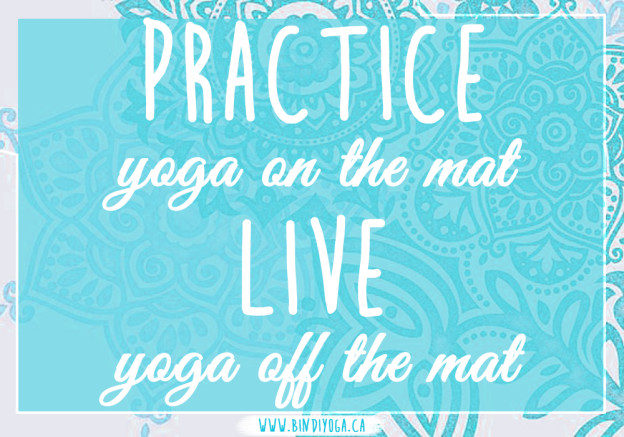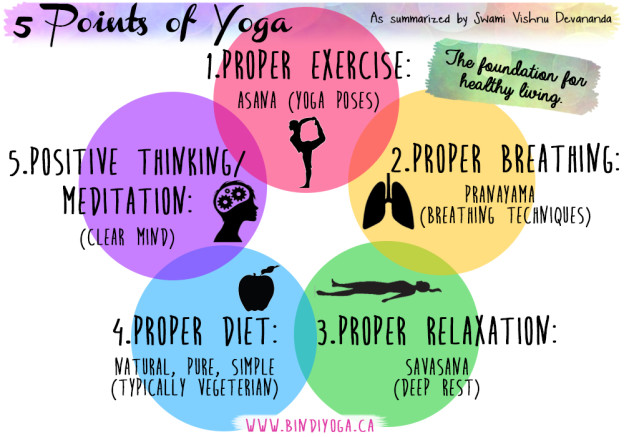“Yoga is the journey of the self, through the self, to the self.”
-The Bhagavad Gita



“Yoga is the journey of the self, through the self, to the self.”
-The Bhagavad Gita

We know the benefits of doing yoga.
We’ve felt them from our practice; we are stronger, more flexible, energized and relaxed.
The physical and mental benefits of asana practice are amazing, but let’s remember the deeper essence of yoga and its subtle teachings in everyday life; off the mat.
Next time you meet your mat, I invite you to notice the subtle and metaphorical teachings within yoga as you balance, breathe and invert and consider how you can take these lessons from your mat and apply them into your daily experiences.
How do you take your yoga off the mat? I want to hear about it below!
-Britney

We have all heard about the physical and mental benefits of yoga. As a yoga and natural health professional, I commonly hear myths and questions about yoga that may be preventing people from trying yoga and receiving the endless benefits. Let us demystify the yoga myths, so everyone can enjoy the perks of a regular yoga practice.
1) I’m not flexible— can I still do yoga?
“I would love to try yoga, but I am soo not flexible…” as a yoga professional, this is one of the most common comments I hear. The answer is yes, yes, yes! And in reality, if you aren’t super flexible, you are actually the perfect candidate to practice yoga. Alignment in postures is key, and your flexibility and range of motion will increase significantly with practice.
2) Is yoga a religion/religious?
This is one of the greatest yoga myths I hear. While yoga may be in religion, religion is not in yoga. Yoga is not a religion nor is it religious in any way. Yoga is a science, an art, and a practice to connect us with our highest Self; if in someone’s personal practice, their intention is to connect them with a deity or to dedicate their yoga practice to becoming closer to a god, then yoga may be a part of their religion. Because of yoga’s intimate nature with the Self, it may be a spiritual path or philosophy of living for body, mind and spirit; however, religion is not a part of yoga.
3) How often should I practice?
How often you should practice depends on your goals within yoga! Personally, I practice daily, but I listen carefully to my body’s innate intuition. Some days, I enjoy 90 minutes of vigorous practice, and other days, all my body wants is 5 minutes in a forward fold or a Savasana.
If you’re just starting out with yoga, try attending 2-3 classes per week to start the habit of prioritizing yoga into your lifestyle; learn the alignment of postures, find a yoga sequence that you prefer, and test out different styles and teachers to discover what suites you and your goals best!
4) Why yoga; how is yoga different from other forms of fitness?
Yoga is a rare form of fitness because it is one of the only fitness modalities that is entirely holistic. Unlike many other forms of fitness that cause more stress and strain in the body and mind, yoga is one form of movement that positively impacts all aspects of our being; the body, mind and spirit. Yoga is unique because it is a science of specific postures to open and heal the body on a cellular level, strengthen and tone all muscles in our body— not just the large muscle groups, it balances our nervous system, hormones, immune system, cellular metabolism and cleanses our natural mechanisms of purification, all while working intimately into our energetic and emotional bodies.
I love running, and weightlifting, and dancing, but I would not be able to practice these other fitness practices if I didn’t have my daily yoga practice to bring me back to that mind, body, spirit experience.
5) I’m a dude— am I going to be the only guy in the class?
Men, we welcome you to yoga with open arms! Thousands of years ago, it was men who traditionally practiced yoga. In our current western world, it is possible that you will be the only one in the room with only one X chromosome, but who cares! Men need zen, too. Over my years of teaching, I see more and more men regularly attend yoga. Men, did you know that you inspire us women, and that you bring a beautiful energy with you to each class? Buy some yoga shorts and come play with us!
6) “I’m too _______ to do yoga.”
Insert negative, self-limiting adjective here. I hear all the time; “I am too fat,” “too old,” “too stiff and sore.” Yoga really is for everyone. If you have an injury, physical limitation or are concerned about where you are fitness-wise, simply talk to your instructor before class. Any qualified and experienced instructor will be happy to offer you modified poses or adjustments to make your practice as healing as possible. There are many different styles of yoga to suit the entire population. From vigorous sweaty Vinyasa or Power yoga, to gentle, stillness based Yin and Restorative yoga, there is a class for you; whatever your age, schedule, or physical ability.
7) What do I need to get started?
The best part about yoga is that you really don’t need anything to get started. In western culture, we have created special yoga clothes, yoga mats, blocks, straps, cushions—even special yoga socks. Ultimately, our body, mind, and breath are all we need to get started, but a yoga mat, water bottle, and comfortable clothing for bending and stretching are what most people start out with for classes. (Many studios have mats, and props for use or rental.)
The physical and mental benefits of yoga are endless and truly accessible to everyone, so let go of the yoga myths, go buy a mat, go check out your local studio, and fall in love!

5 Points of Yoga
(As summarized by Swami Vishnu Devananda)
1) Proper Exercise: Asana (Yoga Poses)
+ The physical body is the house of the soul. Your body is your temple.
+ Asanas were invented to keep the physical body strong, open and well.
+ Open our subtle energy body, so our prana or chi can flow freely within us.
+ Yoga postures focus on the health of the spine, bringing the spine into flexion, extension, side flexion and rotation. A large part of our nervous system is contained in the spine. We are as young, as our spine is flexible.
+ Allows the body to sit for periods of time in meditation.
2) Proper Breathing: Pranayama
+ Control & regulation of prana, subtle energy
+ Practice our ability to use our breath more efficiently, to bring in more oxygen into the body, and remove more carbon dioxide.
+ Many of us don’t breath properly or efficiently, our tissues starve of oxygen and we wonder why we feel tired.
3) Proper Relaxation: Savasana
+ Physical & mental relaxation; resets nervous system, metabolism, flushes cellular waste, reduces stress hormones, balances blood pressure, reduces pain perception.
+ We all know the importance of relaxation.
4) Proper Diet: Typically vegetarian
+ We are what we eat!
+ Pure, simple, natural foods that are easily digested and nourish the body.
+ Fruits, vegetables, nuts, seeds, beans, lentils, herbs, herbal teas, and fresh water.
+ Processing, refining or chemically/genetically modifying our food lowers nutrient content
+ Listen to your bodies innate intuition.
5) Positive Thinking & Meditation
+ Focus the mind, exceed the Ego, deepen our experience, reach the ultimate goal of yoga; Samadhi (enlightenment, bliss.)